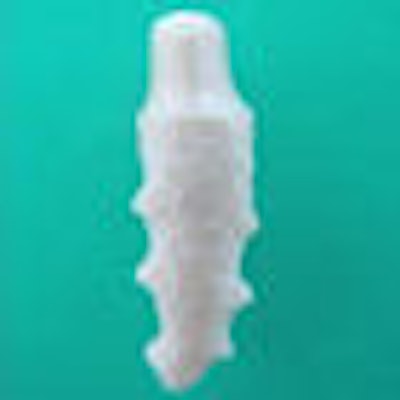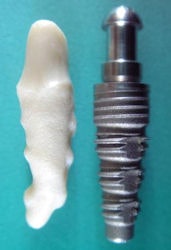
Forget your one-size-fits-all, screw-in-place, run-of-the-mill implants. The artificial teeth of the future will be custom-made in the same shape as the natural teeth they replace.
That, at least, is the dream of researchers in Austria and the U.S.
Customized implants might go in faster, reduce the trauma of surgery, break less easily, distribute occlusal forces more evenly, and look more like natural teeth, according to the researchers.
"With conventional implants, you have to wait a month or six weeks," said Toru Okabe, Ph.D., a biomaterials science professor at Baylor College of Dentistry. "Instead, in 24 to 36 hours, you could get a similar tooth and place it exactly where the old one was."
Okabe's team is experimenting with a CAD/CAM technique by which CT images of a patient's teeth are used to sinter a replica out of titanium powder using electron beam melting.
At the same time, two surgeons -- Wolfgang Pirker, M.D., D.D.S., a Vienna maxillofacial surgeon, and Alfred Kocher, M.D., a Medical University of Vienna surgery professor -- have patented an approach to milling custom zirconia implants.
Past failures
But not all implant experts are confident of this custom-made approach. Kim Gowey, D.D.S., past president of the American Academy of Implant Dentistry, noted that the approach has already been tried and "never took off."
 |
| A custom-made zirconia implant compared to a mass-produced titanium implant. Image courtesy of Wolfgang Pirker, M.D., D.D.S. |
"Custom implants are bigger, and they don't have a margin of error with bone shrinkage," he said.
The Vienna duo acknowledged that previous attempts at custom implants going back to 1969 have failed. Most notably, a German product, the Re-Implant, had good short-term results but a high long-term failure rate, according to their Web site and a case report in the International Journal of Oral and Maxillofacial Surgery (IJOMS, March 2008, Vol. 37:3, pp. 293-295).
Drs. Pirker and Kocher think they've overcome these problems by adding new features to the implants, making them a bit different from exact duplicates of the teeth they replace. Their implants are designed to go into the socket of an extracted tooth. Once the tooth is extracted, they scan it by laser, then mill a replacement. (Another alternative is to create an impression of the socket and scan that instead of the tooth itself.)
"In several instances, implant insertion led to fractures of the thin buccal wall of the alveolar bone," they wrote, acknowledging Dr. Gowey's biggest concern. They seek to reduce the pressure by reducing the implant's diameter by 0.1 mm to 0.3 mm near the buccal cortical bone.
They think they've licked another nagging problem as well. "A perfect fit of the implant without any retentions might be responsible for the intermediate-term failure, because of the subsequent uniform pressure-induced resorption concerning the entire alveolar surface simultaneously," they wrote.
So they've added macroretentions -- small bumps -- onto the implant in the interdental space that they say exert pressure only on spongy bone, not cortical bone. They're using zirconia (specifically yttria-stabilized tetragonal zirconia polycrystal), which osseointegrates as well as titanium but is closer to the color of natural teeth. And they have roughened the surface of their implants by sandblasting them to further hasten osseointegration.
Pros and cons
These new implants have several advantages, according to Drs. Pirker and Kocher. Conventional implants were designed for insertion into healed bone, not into extraction sockets, they said.
| Placement of custom-made zirconia implant. Video courtesy of Wolfgang Pirker, M.D., D.D.S. |
| Having trouble viewing this clip? Click here to download the free Flash player. |
Conversely, unlike conventional implants that must be screwed in, doctors can tap the custom-made implants directly into the socket with a small mallet. The procedure is flapless and takes only a few minutes. Risk to adjacent structures, such as dental roots, mandible nerves, and maxillary sinuses, is minimized.
And because of the exact fit, the implant-bone contact is greater, leading to better initial stabilization and long-term osseointegration, they explained.
Drs. Pirker and Kocher do acknowledge some disadvantages, though. The procedure is limited to single-stage implants, and patients with damaged periodontal ligaments are excluded because the position of a misaligned tooth can't be corrected.
Finally, the Vienna doctors don't have much long-term data to support their product. They have enrolled more than 35 patients in a trial, and report a 90% success rate at four-year follow-up, they noted. However, they have so far only published the 2008 IJOMS case report.
The titanium alternative
Meanwhile, Dr. Okabe and colleagues published an article in JOM, the journal of the Minerals, Metals and Materials Society (November 2008, Vol. 60:11, pp. 50-55), describing possible advantages to the implants they would sinter out of titanium.
Their design is stronger than conventional implants because the implant and abutment are in one piece (the crown still needs to be attached separately), according to the researchers.
And they hope their approach will avoid the problem of stress shielding, which occurs with conventional implants because bone strengthens or weakens based on the load exerted on it. Conventional implants are stiffer than bone, so the occlusal load transfers to the implant. As a result of the reduced stress, the surrounding bone weakens and the implant can loosen and fall out.
Dr. Okabe and colleagues propose to manufacture the implant with a lattice structure that will mimic the strength of a natural tooth so that it doesn't take on more than its share of the load. In addition, the lattice would increase the implant's surface area, which could speed osseointegration.
Most of their JOM article focuses on the manufacturing process. The process would begin with a CT scan of the tooth before extraction. The computer then divides the 3D image into slices. Next an electron beam fires at a layer of titanium powder on a stainless steel tray, melting it into the shape of a slice. More powder is added and melted into the shape of the next slice. The process continues until all the slices have been created and fused together into a single tooth.
While the researchers have constructed teeth this way, they have not yet tried them in human beings; animal trials are under way.
"It's just a dream," Dr. Okabe said. "But it's possible."
Copyright © 2009 DrBicuspid.com



















